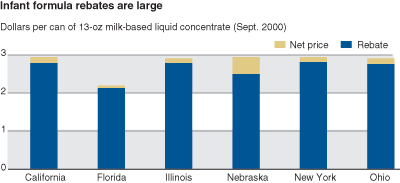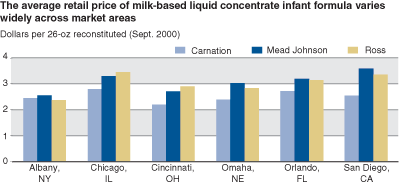Sharing the Economic Burden: Who Pays for WIC's Infant Formula
- by Victor Oliveira and Mark Prell
- 9/1/2004
Proper nutrition during an infant’s first year is essential for long-term growth and development. Although breastfeeding is the best nutritional method of feeding most babies, not all mothers breastfeed their infants. For these infants, infant formula is a key, or even sole, source of nutrition during their first months of life. Each month, USDA’s Special Supplemental Nutrition Program for Women, Infants, and Children, commonly known as WIC, provides infant formula at no cost to almost 2 million nutritionally at-risk infants in low-income households. In fact, over half of all infant formula sold in the United States is obtained through WIC. But while WIC’s infant formula is free to WIC participants, “there’s no such thing as a free lunch.” Infant formula is no exception to this elementary lesson of economics.
As with other Federal programs, WIC is funded by the U.S. Treasury. Taxpayers alone, however, do not bear the full economic burden of WIC. Infant formula manufacturers provide the State agencies administering the WIC program with rebates of 85 to 98 percent of the wholesale price for each can of formula purchased by WIC participants. These rebates totaled $1.48 billion in fiscal 2002 and supported over a fourth of WIC’s participants.
A recent ERS study of infant formula prices in 47 local areas found that non-WIC households who pay for infant formula out of their own pockets share some of the economic burden as well. The study found that an indirect effect of the program is slightly higher infant formula prices in supermarkets. For example, depending on the brand, feeding an average 3-month-old girl costs between $78 and $92 per month, but monthly costs increase anywhere from $0.32 to $5.26 if the girl’s family lives in an area where WIC participation is significantly higher than the national average. The ERS study focused on retail pricing behavior by supermarkets, setting aside wholesale pricing behavior by infant formula manufacturers.
WIC Serves Almost Half of U.S. Infants
WIC is one of the central components of the Nation’s nutrition assistance system. About half of all infants, a quarter of all children ages 1-4, and a third of all pregnant women participate. Federal program costs were $4.5 billion in fiscal 2003, making WIC the country’s third-largest nutrition assistance program, behind the Food Stamp Program ($23.9 billion) and the National School Lunch Program ($7.2 billion) (see box, “WIC Facts”).
As a supplemental nutrition assistance program, WIC provides vouchers for specific foods that supply target nutrients—specifically protein, iron, vitamins A and C, and calcium—identified as lacking in the diets of low-income pregnant, breastfeeding, and postpartum women and their infants and young children. WIC-approved food categories include milk, eggs, cheese, cereal (hot and cold), infant cereal, juice, peanut butter, dried beans or peas, canned tuna, carrots, and infant formula. WIC infants receive up to thirty-one 13-ounce cans of liquid formula (or its equivalent) per month—an amount that accounts for most infants’ formula needs.
Participants exchange the vouchers for WIC-approved foods at authorized retail outlets, such as supermarkets, small grocery stores, and pharmacies. Retailers submit the vouchers to their bank, which in turn submits them to the WIC State agency to be reimbursed the retail or shelf price of the WIC items.
Formula Manufacturers Offer Big Rebates
WIC was established in the early 1970s. By the mid-1980s, infant formula was accounting for an increasingly large share of total WIC food costs. In an effort to control costs, several States implemented rebate programs with manufacturers of infant formula. As a result of the cost savings from these rebate programs, a Federal law was passed in 1989 requiring WIC State agencies to develop cost-containment systems for the procurement of infant formula.
Most WIC State agencies obtain discounts in the form of manufacturers’ rebates for each can of formula that WIC participants “purchase” (by exchanging vouchers). In return for the rebates, a formula manufacturer receives an exclusive sales arrangement within the State. That is, WIC participants in the State are given vouchers that can be redeemed only for that brand of formula, making that manufacturer the sole supplier to the WIC market in the State. Each State’s WIC contract is awarded to the manufacturer that bids the lowest net price—wholesale price less the rebate. Thus, the brand of infant formula purchased by WIC participants (the contract brand) can vary from State to State. The State WIC agency bills the contract-winning manufacturer for the rebate specified in the contract. The rebates’ effect on WIC program cost is substantial. In fiscal 2002, it is estimated that infant formula accounted for about 46 percent of total WIC food costs on a pre-rebate basis but only 21 percent on a post-rebate basis.
Rebates per can of formula also vary across States and ranged from 85 to 98 percent of the manufacturer’s wholesale price in fiscal 2000. As a result, the highest net price a manufacturer received for WIC- provided infant formula was only 15 percent of the wholesale price. Net prices in September 2000 ranged from 6.5 cents (per can of milk-based liquid concentrate) in Florida to 44.7 cents in Nebraska and South Dakota. For the U.S. as a whole, net prices averaged 18 cents per can in fiscal 2000.
Both supply-side and demand-side characteristics of the infant formula market help to explain how WIC State agencies can receive such large rebates. On the supply side, the formula market is highly concentrated: in 2000, three companies—Mead Johnson (52 percent), Ross (35 percent), and Carnation (12 percent)—accounted for 99 percent of the infant formula market. A high degree of concentration is often associated with high profit margins, which, in turn, give manufacturers the cushion to offer high rebates. On the demand side, WIC participants purchase over half of all infant formula, assuring large sales for the contract-winning manufacturer. In addition, manufacturers can realize spillover benefits of winning a WIC contract: retailers may devote increased shelf space to the WIC contract brand, which may then lead to increased sales of the brand to non-WIC participants. Sales may also rise if physicians recommend the WIC contract brand to non-WIC mothers. While manufacturers would prefer a higher net price, stipulating a higher net price in a contract bid could jeopardize a formula maker’s chances of winning the contract. Ongoing ERS research is examining factors that affect net formula prices across States.
WIC Raises Infant Formula Prices Slightly
Each of the three major formula manufacturers sets a national wholesale price schedule for retailers, with price based on the size of the purchase. Thus, wholesale prices for a given brand and amount of formula do not vary by geographic area. Any differences in a brand’s retail prices across major market areas are determined primarily by variation in the retail markup—the difference between the retail price and the wholesale price. Retail prices for a particular brand of infant formula vary significantly across the country. For example, the average retail price of a can of Mead Johnson’s Enfamil milk-based liquid concentrate was $2.56 in supermarkets in Albany, NY, in 2000. In San Diego, CA, the same product sold for $3.59. In addition, in any local market, different manufacturers’ brands of formula sell for different prices. Notably, Carnation brand formula typically sold for less than the brands of Ross and Mead Johnson in 2000, due in part to Carnation’s lower wholesale price.
WIC can be thought of as creating two separate markets for infant formula: the WIC market and the non-WIC market. WIC households obtain formula at no cost and are therefore price insensitive, while non-WIC households must pay for the infant formula they purchase and are relatively price sensitive. Federal regulations prohibit retailers from charging WIC participants more than non-WIC customers. However, in local areas where WIC households make up a large share of the area’s formula-buying households, retailers have an incentive to increase the price for the WIC contract brand of formula. Retailers will then receive a higher reimbursement when the WIC vouchers are submitted to the WIC State agencies. (WIC State agencies have the authority to limit the price that WIC-authorized vendors can charge for the WIC contract brand of formula, thus discouraging retailers from charging exorbitant prices for infant formula.)
An ERS analysis of 47 local areas found that WIC and its infant formula rebate program do affect the retail price of formula. Controlling for other factors—such as wholesale price and household income—a manufacturer’s brand of formula was priced higher if it was the WIC contract brand in an area. For a dozen types of infant formula examined, prices increased up to 6 cents (per 26 ounces reconstituted) for the contract brands.
WIC’s relative size in a local area, as measured by the ratio of WIC to non-WIC formula-fed infants, affected retail prices of contract brands as expected. And, in areas where the relative size of WIC is large, retailers have an incentive to raise the price of noncontract brands of formula as well. Once retailers establish a higher price for the contract brand, some non-WIC households may choose to switch to the noncontract brand, resulting in an increase in demand for the noncontract brand. However, retailers have more incentive to increase the prices of WIC contract brands, as WIC households will not change their purchasing behavior if contract-brand prices rise.
What is the impact of these price effects on the monthly budget of a non-WIC family? The formula needs of infants vary. Parents of a 3-month-old girl typically spend between $78 and $92 per month (in 2000 dollars) for milk-based powder formula, depending on brand. If this family moved from an area where half of all formula-fed infants are in WIC to an area where two-thirds are in WIC, their monthly expenditures for infant formula bought in supermarkets would typically increase. For milk-based formula, the most popular type, expenditure increases ranged from $2.87 to $5.26 per month for contract brands and from $0.32 to $4.52 per month for noncontract brands.
Who Pays?
WIC and its infant formula rebate program have been successful in terms of making infant formula available to needy infants at a low monetary cost. With rebates from the formula manufacturers, the cost of the formula to taxpayers is a small fraction of its wholesale price. However, an indirect effect of the program is higher retail prices for non-WIC consumers of infant formula. WIC and its infant formula rebate program each affect the supermarket price of infant formula, although the estimated impact on a non-WIC family’s monthly expenditures for infant formula is modest. Balancing these modest price effects is the fact that rebates support over one of every four participants in the WIC program, or almost 2 million low-income people per month in fiscal 2003.
WIC is working to increase breastfeeding rates among WIC mothers (see box, “WIC and Breastfeeding Rates”). If successful, these efforts could decrease the ratio of WIC to non-WIC formula-fed infants. With price-insensitive WIC participants making up a smaller component of the infant formula market, WIC’s influence in the retail infant formula market will be lessened, resulting in lower retail prices for both contract and noncontract brands of infant formula for non-WIC consumers.
This article is drawn from:
- WIC Program. (n.d.). U.S. Department of Agriculture, Economic Research Service.
- Oliveira, V., Prell, M., Smallwood, D. & Frazão, E. (2004). WIC and the Retail Price of Infant Formula. U.S. Department of Agriculture, Economic Research Service. FANRR-39-1.
- Oliveira, V., Prell, M., Smallwood, D. & Frazão, E. (2001). Infant Formula Prices and Availability: Final Report to Congress. U.S. Department of Agriculture, Economic Research Service. EFAN-02-001.
- Oliveira, V. (2003). Food Assistance Research Brief-WIC and Breastfeeding Rates. U.S. Department of Agriculture, Economic Research Service. FANRR-34-2.
We’d welcome your feedback!
Would you be willing to answer a few quick questions about your experience?



